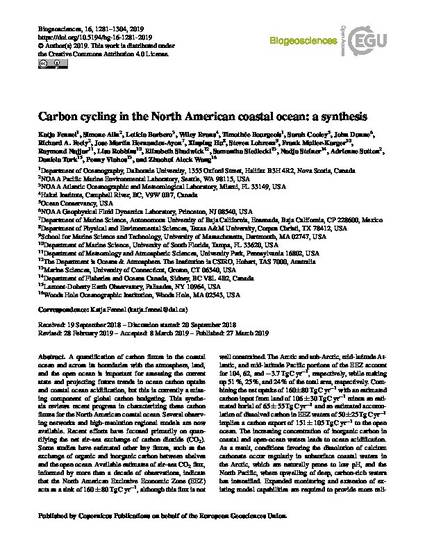
A quantification of carbon fluxes in the coastal ocean and across its boundaries with the atmosphere, land, and the open ocean is important for assessing the current state and projecting future trends in ocean carbon uptake and coastal ocean acidification, but this is currently a missing component of global carbon budgeting. This synthesis reviews recent progress in characterizing these carbon fluxes for the North American coastal ocean. Several observing networks and high-resolution regional models are now available. Recent efforts have focused primarily on quantifying the net air–sea exchange of carbon dioxide (CO2). Some studies have estimated other key fluxes, such as the exchange of organic and inorganic carbon between shelves and the open ocean. Available estimates of air–sea CO2 flux, informed by more than a decade of observations, indicate that the North American Exclusive Economic Zone (EEZ) acts as a sink of 160±80 Tg C yr−1, although this flux is not well constrained. The Arctic and sub-Arctic, mid-latitude Atlantic, and mid-latitude Pacific portions of the EEZ account for 104, 62, and −3.7 Tg C yr−1, respectively, while making up 51 %, 25 %, and 24 % of the total area, respectively. Combining the net uptake of 160±80 Tg C yr−1 with an estimated carbon input from land of 106±30 Tg C yr−1 minus an estimated burial of 65±55 Tg C yr−1 and an estimated accumulation of dissolved carbon in EEZ waters of 50±25 Tg C yr−1 implies a carbon export of 151±105 Tg C yr−1 to the open ocean. The increasing concentration of inorganic carbon in coastal and open-ocean waters leads to ocean acidification. As a result, conditions favoring the dissolution of calcium carbonate occur regularly in subsurface coastal waters in the Arctic, which are naturally prone to low pH, and the North Pacific, where upwelling of deep, carbon-rich waters has intensified. Expanded monitoring and extension of existing model capabilities are required to provide more reliable coastal carbon budgets, projections of future states of the coastal ocean, and quantification of anthropogenic carbon contributions.
Biogeosciences, v. 16, p. 1281-1304
Available at: http://works.bepress.com/frank_muller-karger/42/

Complete list of authors:
Katja Fennel, Simone Alin, Leticia Barbero, Wiley Evans, Timothée Bourgeois, Sarah Cooley, John Dunne, Richard A. Feely, Jose Martin Hernandez-Ayon, Xinping Hu, Steven Lohrenz, Frank Muller-Karger, Raymond Najjar, Lisa Robbins, Elizabeth Shadwick, Samantha Siedlecki, Nadja Steiner, Adrienne Sutton, Daniela Turk, Penny Vlahos, and Zhaohui Aleck Wang